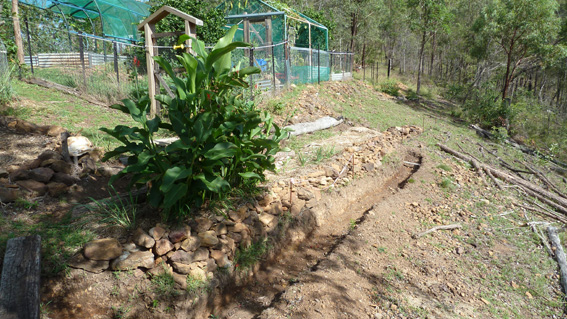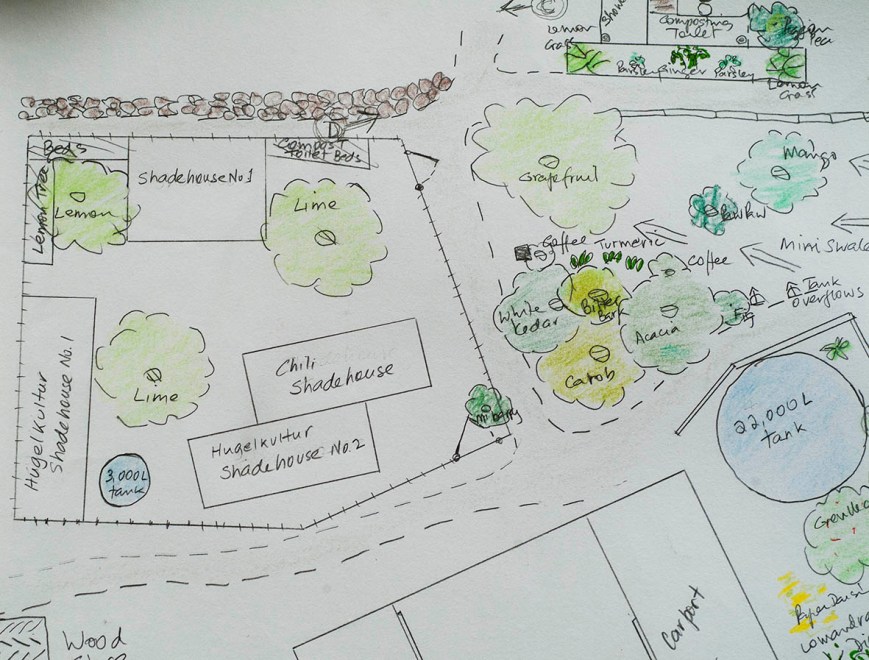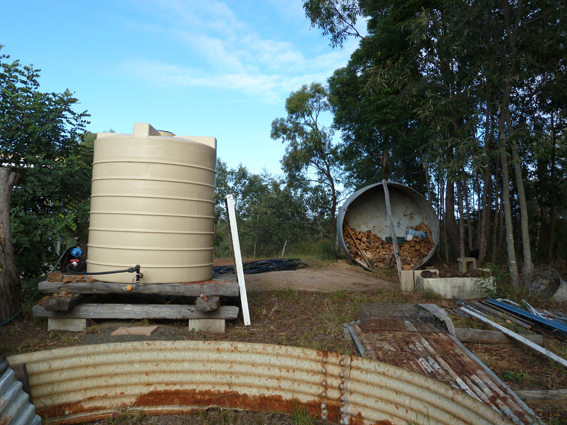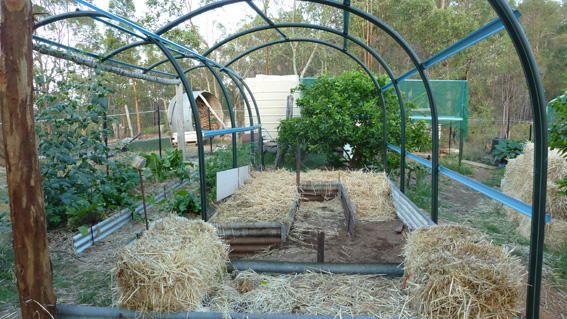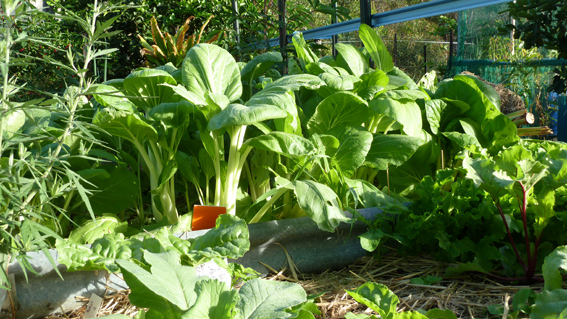This post is a work-in-progress compilation of material on growing this delicious and low maintenance fruit. I will edit it from time to time as I come across more/better material.
[Sunday night Oct 5: Have just revised the links at the bottom of this page – quite a few useful sites there now]
[October 6: added table of nutritional values of pitaya, added photos and associated text, added new links to source]
Our Dragon Fruit Experience
We started out with some cuttings of red dragon fruit in 2010 or early 2011. They grew successfully in large pots, but we didn’t have anywhere where we could plant them out, so they stayed in the pots for ages, with some eventually extending roots through the bottoms of the pots and into the ground. These plants are nothing if not hardy.
Three of them were planted out on a beam trellis in a shade tunnel in mid-2011 (the 30% shade cloth on these tunnels is extended only during the hotter parts of the summer).

First dragon fruit bud – February 2012 – while the plant was still in the original pot
Two buds were produced in late summer 2012 – probably in late summer because the plants were not sufficiently established to flower earlier that summer. Neither of these produced fruit. In the 2012/13 summer we had two flowers and two fruit.
In October 2012 one-third of the floor or the shade tunnel was dug out to a depth of 200-300mm and filled with dead timber, including tree trunks, branches, twigs and leaves, and chip mulch from our annual firebreak clearing, then covered over with the soil taken out of the hole (or rather the two-thirds of the soil that remained after the rocks had been sieved out) to make a modified heugelkultur/raised garden bed. That’s the lush area in the background of the photo below, 10 months later.

One of the dragon fruit on the trellis – late July 2013. This shot gives you an idea of the post and beam trellis. It actually recommended for red dragon fruit, but I fail to see why, and I know a commercial grower who has changed over from this to post and frame trellises.
In late July 2013, just before the photo above was taken, the remainder of the floor of the shade tunnel was turned into a modified heugelkultur bed. The raised bed on top of the timber was a lasagne bed with layers of straw, poultry manure (including quite a few carcases), and compost.
By late December 2013, only five months later, the dragon fruit had responded dramatically.

The same plant as above, but five months later (there is a second plant growing up the post in the background, but the branches here are from the one in the foreground).
We eventually had seven fruit from nine flowers on four plants from the 2013/2014 summer, harvesting the last of the fruit in May and June. One fruit didn’t develop, and one was on a new plant growing out in “possum land” beyond the electric fence and was eaten by the possums before it was ripe.

The same plant in mid-2014 prior to pruning
In hindsight it was really dumb to plant dragon fruit above a vegetable bed inside a rather narrow shade tunnel. These things need to be able to grow as wide as they want, and they need to have a combination of old and new branches hanging down (fruit comes from both). It just doesn’t work, and forgetting that the vines are there and standing up under one to get one of those small spines in the soft part of the ear is not fun. As soon as we get an extension to the garden fenced we will be planting lots of dragon fruit there, from cuttings off these plants.
Propagating via Cuttings
While it is possible to propagate dragon fruit from seeds, it is along process and does not result in a vine with the same fruit producing properties as the parent. With the cuttings you are getting a clone of the parent, and much more quickly.
You can make multiple stem cuttings from the one piece of stem, but focus on the lower and middle portions of the stem (away from the growing tip) to get the most robust material. If you have an “intermediate” section of stem with narrow stem portions at each end, then it probably doesn’t matter where you take the cutting.
Try to use a stem that is a few inches in diameter (> 2 inches), but smaller stems will work – the danger is that the stem may dry up too much when being “cured” or before it produces roots in the pot. Thicker cuttings suffer less stress.
When you make a fresh cutting, it’s best to place it in a shady location for a week or more to allow the cut end to dry and “heal” to avoid fungal infections, before placing it into soil. You may see roots starting to develop during this period, but it is not necessary to wait for roots before potting the cured cutting.
Thereafter, a good, well-drained potting mix will serve to encourage roots to grow.
Water once every one to two weeks and let the soil dry up, too wet can cause fungus attack. Keep mulch away from the base of the plant to avoid introducing fungi and rot.
With filtered sunlight and warm temperature, the vine will grow a root first, then, once the root is established, new branches will sprout from the nodes.
When new growth appears (this may take as long as four months, depending on the weather and season) they are ready to plant in the ground in a sunny location.
Growing the Mature Plant
Dragon fruit need to grow up a trellis, but they need to be able to “hang” their side branches out from the main stem (or from a beam or frame on top of the trellis) in an arc.
Remove lateral growth until the stems reach at least a few feet up their support. Then you can prune the tips of the stems to induce multiple branching, and eventually, fruiting.
This cactus develops some pretty thick and heavy stems, so your support will need to ultimately hold quite a bit of weight. Use twine or bands of fabric to help attach it to the support, avoiding wires that can cut into the weighty stems. Eventually the stems will grow aerial roots to grip onto the support.

A man inspects dragon fruit trees on a plantation in rural Cambodia. Photograph: Heng Chivoan/Phnom Penh Post: 30/7/12
This plant is very efficient because it can grow roots on any surface. It can also absorb water and nutrient through any surface. It can also utilize low light or partial shade but it grows better in full sun. BUT be careful when the plant is moved from low light to full sun – on very hot days the vine can sunburn easily. Growth and fruiting are better in full sun (and the plant needs at least half a day of sun), but in the hotter part of summer I use 30% shade cloth.
Flowering, Pollination and Fruit Development
The main flowering is in summer and then fruit develop into autumn and winter, however the time taken to reach maturity depends on the size of the fruit, so from flowering to ripe can be as short as six weeks or, more usual, several months.
[Need to add more information here]
Feeding Your Dragon Fruit
Dragon fruit needs low nitrogen and high phosphorus in the soil, particularly as it approaches, and during, the growing and fruiting season. They “hibernate” in winter in our climate.
Pruning
When your plant is at least one year old, strong and vigorous, and ideally having proven its ability to bloom and fruit abundantly (this may take 18 months to two years in our climate), you can begin to take stem cuttings. Because the plant needs to be pruned once it is mature and has fruited (in order to produce many new side stems and therefore many fruit) you will have an opportunity every year to make cuttings from the pruned material.
It is on the new branches sprawling over the top of the support structure where most of the new flowers are produced, although flowers can pop-up anywhere on the plant.
The Nutritional Value of Dragon Fruit
Some useful links
NT Government AgNote D42: The Pitaya or Dragon Fruit A four-page technical note on key aspects of cultivation.
NT Government Growing Note: Pitaya (Dragon Fruit) One-page note with some material not covered in above AgNote
Dragon Fruit Production Guide (Pinoy Bisnes Ideas) A lot of good information, some of it in more detail than the above publications.
Pitaya Growing in the Florida Home Landscape One of the most complete sources I have found on growing dragon fruit.
Dragon Fruit (Pitaya) – How-to Guide for Growing Includes a video on hand pollination. A very good source of information on growing dragon fruit, with some information that I hadn’t seen elsewhere. This is actually an Australian self-sufficiency website, and the author is based in South East Queensland.
Pruning Pitaya (Dragon Fruit) (Sub-tropical Fruit Club of Queensland Instruction with photos for pruning. Use the search box on this page “pitaya” for a huge amount of useful/interesting information on Dragon Fruit
Dragonfruit Cactus (Botanical Growers Network publication) Some of the information fills gaps in the above sources, or gives a different slant on some topics.
Improved Production Technology for Pitaya (Philippines Bureau of Agricultural Research) Check info on when to prune, time to first production and time from flowering to harvest.
http://dragonfruit.foodlywise.com/ An annoying site because of its strange links but there’s some good information if you can figure out how to follow them.
http://dragonfruit.foodlywise.com/how_to_grow_dragonfruit/growing_dragonfruit_commercially/growing_dragonfruit_from_cuttings/dragonfruit_stem_cuttings/ Covers several aspects of growing dragon fruit from cuttings.
http://www.vivapitaya.com/dragon-2.htm A selection of photos of dragon fruit growing in different circumstances – some ideas for supports, and indications of what healthy plants look like in the tropics.


































